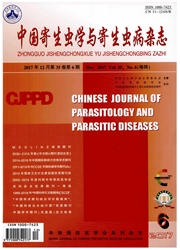

 中文摘要:
中文摘要:
目的对斯氏按蚊TEP1基因与抗疟药硝喹诱导约氏疟原虫卵囊黑化反应的相关性进行初步研究。方法斯氏按蚊吸血感染约氏疟原虫后,随机分为两组(各300只),A组喂饲含0.1%硝喹蔗糖水,B组喂饲10%蔗糖水。另设正常对照组(C组),常规蔗糖水饲养。分别于用药后第1、2、3和4天,取各组雌蚊的血淋巴(各50只),提取cDNA模板,设计引物,克隆斯氏按蚊TEP1基因,用荧光定量PCR检测TEP1基因在抗疟药硝喹诱导下的变化;同时解剖各组雌蚊(各25只),光镜观察约氏疟原虫卵囊的黑化情况,分析TEP1基因与抗疟药诱导的黑化反应的关系。结果成功克隆TEP1基因,推测其氨基酸序列含有TEP分子高度保守的硫酯序列区(GCGEQ)。荧光定量PCR检测结果显示,抗疟药硝喹可诱导斯氏按蚊TEP1基因表达上调,于诱导后第3天,A组的TEP1基因相对表达量为2.423,是B组(1.036)的2.5倍,两者差异有统计学意义(P〈0.05)。相同时点,光镜观察显示,A组蚊经硝喹诱导后的约氏疟原虫卵囊出现黑化现象,黑化率约14.0%,而B组则未发现有黑化现象。结论抗疟药物硝喹可诱导斯氏按蚊TEP1基因上调,该基因与约氏疟原虫卵囊黑化相关。
 英文摘要:
英文摘要:
Objective To analyze the relationship between the TEP1 gene of Anopheles stephensi and melanotic encapsulation of Plasmodium yoelii induced by anti-malaria drug nitroquine. Methods Haemolymph samples from three groups of An. stephensi fed with sucrose solution, Plasmodium-infected blood and nitroquine, respectively, were collected at the 1st, 2nd, 3rd and 4th day after drug adminstration. Degenerate primers were designed according to the conserved amino acid sequence within TEPs of the mosquitoes. Fluorescent quantitation PCR was used to detect the variation of TEP1 gene transcript induced by nitroquine. The melanization of oocysts was observed by light microcopy. Results TEP1 gene was cloned, the predicted amino acid residues harbored a highly conserved canonical thioester motif GCGEQ. The fluorescent quantitation PCR revealed that nitroquine induced an up-regulation of TEP1 activity. The transcription of TEP1 gene in nitroquine treated group (2.423) was significantly higher than that of the infected blood-fed group(1.036) at the 3rd day after nitroquine treatment (P〈0.05). At the same time, most oocysts were found to be encapsulated in nitroquine treated group, while no melanized parasites were observed in the infected blood-fed group. Conclusion Transcriptional variation of TEP1 gene may be related to the melanization induced by nitroquine.
 同期刊论文项目
同期刊论文项目
 同项目期刊论文
同项目期刊论文
 期刊信息
期刊信息
